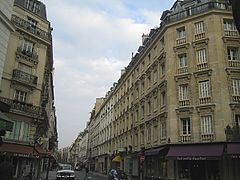Length 975 m (3,199 ft) To Rue Coquillière Completed 5 March 1838 | From Rue des Archives Completion 5 March 1838 | |
 | ||
Width 5.5 to 13 m (18 to 43 ft) Arrondissements | ||
Paris france video tour of a vacation rental in le marais rue rambuteau
The Rue Rambuteau is a street in Paris named after the Count de Rambuteau who started the widening of the road prior to Haussmann's renovation of Paris. Philosopher Henri Lefebvre lived on the street and observed from his window the rhythms of everyday life at the intersection located behind the Centre Georges Pompidou.
Contents
- Paris france video tour of a vacation rental in le marais rue rambuteau
- Map of Rue Rambuteau Paris France
- Location
- History
- Buildings
- References
Map of Rue Rambuteau, Paris, France
Location
Rue Rambuteau is a street in central Paris that connects the neighborhood of Les Halles, in the 1st arrondissement, to the Marais district in the 4th arrondissement. It fronts the Forum of Les Halles and the north side of Centre Georges Pompidou, and marks the boundary between the 3rd and 4th arrondissements. It occupies a special place in the history of Paris, because it is the first street to pierce the medieval center, during the reign of Louis Philippe I, a few years before the great work of Baron Haussmann. Rue Rambuteau has a length of 975 metres (3,199 ft) and a width of 13 metres (43 ft).
History
Rambuteau Street was created by order of King Louis Philippe I dated 5 March 1838. In 1839 the street was given the name of the prefect of the Seine department, Claude Philibert Barthelot, Count Rambuteau. The new street absorbed the Rue des Ménétriers, between Rue Beaubourg and Rue Saint-Martin; Rue de la Chanverrerie between Rue Saint-Denis and Rue Mondétour; and the Rue Traînée between Rue Montmartre et Rue du Jour.
The prefect Rambuteau, at the request of residents, decided in 1834 to create a street 13 metres (43 ft) wide, an important dimension for the time. The center of Paris had hitherto kept its medieval urban fabric composed mainly of narrow streets where traffic was difficult and hygiene was poor. Taking office in 1833, a year after a major cholera epidemic, Rambuteau decided to implement the hygienist theories of the time by cutting a wide path through the center of Paris. A few years later, the prefect Haussmann would apply Rambuteau's principles on a much larger scale in boulevards such as the Boulevard de Sébastopol that crosses the Rue Rambuteau.
In 1904 the visionary urban planner Eugène Hénard presented a project for a new major east-west crossing of Paris. The east-west artery, the new Avenue du Palais-Royal, would run along the route of the Rue Rambuteau, which would be expanded, through the Palais-Royal and into the Avenue de l'Opéra. The avenue would pass through arches cut through the wings of the Palais Royal. It would intersect an expanded north-south Rue de Richelieu in a roundabout, cutting into the west side of the Palais-Royal. The entire project was discussed for several years, and in 1912 gave rise to great controversy within the Commission of Old Paris. However, the proposal did not gain official support.
Buildings
Rue Rambuteau is served by the Rambuteau station at the Pompidou center and the Les Halles station at the Forum des Halles. The entrance to the latter station is inserted in the front of a building at number 230.
